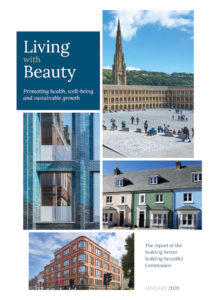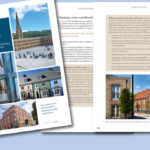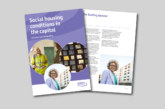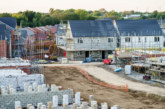 The Building Better, Building Beautiful Commission’s final report launched at the Garden Museum in Lambeth on the 30th January. Living with Beauty supports the creation of more beautiful communities and makes a number of recommendations, including increasing democracy and speeding up the planning process. LABM rounds up opinion from across the industry to the new report.
The Building Better, Building Beautiful Commission’s final report launched at the Garden Museum in Lambeth on the 30th January. Living with Beauty supports the creation of more beautiful communities and makes a number of recommendations, including increasing democracy and speeding up the planning process. LABM rounds up opinion from across the industry to the new report.
Well-designed, high quality homes and tree-lined streets should be the ‘norm — not the exception’, Housing Secretary Rt Hon Robert Jenrick MP said, following the launch of the Building Better Building Beautiful Commission’s final report.
Living with Beauty — led by the late Sir Roger Scruton and Nicolas Boys Smith — contains over 130 practical recommendations to support the creation of more beautiful communities, including:
- planting millions of trees over the next five years, as well as opening old canals and supporting every home to have its own or access to a fruit tree.
- speeding up the planning process for beautiful buildings through a new ‘Fast Track for Beauty’ rule for councils.
- increasing democracy and involving communities in local plans and planning applications, including using digital technology like virtual reality and 3D modelling to help locals shape their own areas.
Housing Secretary Rt Hon Robert Jenrick MP said the report is important for many reasons, “not least because of the powerful argument it makes that a sense of place still matters — and, arguably, in our fast-paced, globalised world, matters perhaps more than ever.
“It recognises that our identities go hand in hand with the places and neighbourhoods in which we live and work. That’s why beautiful, high-quality homes must become the norm, not the exception.
Mr Jenrick said that there was plenty of evidence that instead of holding housebuilding back “championing quality would help us go further”.
The Housing Secretary added: “I am interested in the proposal of a ‘fast track for beauty’. Where individuals and developers have put in the time to create proposals for well-designed buildings, which use high quality-materials and take account of their local setting, it can’t be right their planning applications are held up.
“I too want to see a return to planting more trees. We set out in our manifesto that we will expect all new streets to be lined with trees and are working to make this commitment a reality.
“I want to see zero-carbon homes being built as standard within five years as we learn again how our built and natural environments can work in harmony. And the report is right that local authorities will need to play a leading role in this design revolution. We will need to ensure they have the right skills and leadership to fully carry out their role as place-makers.
“I am therefore determined to do all I can to help achieve the goal you’ve set in the report’s conclusion — that we should aspire to pass on our heritage, the best of who we are and what we have, to our successors, not depleted but enhanced.”
Biophilic design
In response to the new report Félicie Krikler, Director at Assael Architecture, commented: “As architects and designers, it’s our responsibility to create places that will improve the lives of residents and support their mental and physical wellbeing. Countless amounts of research in recent years has shown the importance of biophilic design in improving our mental health and the consumer demand for green design. It’s great to see that the Building Better, Building Beautiful Commission is pushing for government action to plant two million street trees within five years. But as designers, we shouldn’t be reliant on regulation. Instead, we must start listening to those who reside on our developments as they hold the key to unlocking insight into how we can create beautiful places to live and work.”
More resources needed for planning
Responding to the report Cllr David Renard, the Local Government Association’s Planning Spokesman, said: “Councils are committed to building the homes the country desperately needs and healthy prosperous places for people to live, work and play in. We want to work with government on standards to future-proof all new homes and ensure they are accessible for all ages and environmentally sustainable.
“It is vital that the planning process is protected as part of this, and that local communities have a say over the area they live in. This is the best way to ensure homes are built to high standards with the necessary infrastructure in place, and affordable housing provided.
“Planning departments also need to be properly resourced, and allowed to set their own planning fees, with taxpayers currently footing a £200m annual bill to cover the cost of processing applications.
“Planning is not a barrier to housebuilding with councils approving nine in 10 planning applications and are granting permission for more homes than are being built.
“We are pleased this report recognises the challenges around permitted development rules. We urge government to go further and scrap them altogether, handing communities back the ability to oversee all developments.”
The role of offsite
Dave Sheridan, Executive Chairman at ilke Homes, said: “Given the enormity of the climate change challenge, it is crucial that as an industry we make determined efforts to shift towards a far-more sustainable approach. By switching to offsite manufacturing, we can quickly deliver the zero-carbon homes of the future.
“Offsite manufacturing consumes considerably less energy than traditional construction methods, and is the most efficient method of delivering high-quality and highly-sustainable homes at speed. If we are to get serious about tackling the climate crisis, then offsite manufacturing will have to play a much bigger role. At present, far too many new builds are failing in terms of their energy-efficiency.”
Tackling the housing crisis
Dean Clifford, Co-founder of Great Malborough Estates, commented: “Few could argue that many of today’s housing estates are soulless and uninspired or that a lot of modern architecture grates against what most people consider ‘beautiful’ but there is a real danger here in having the Government become an arbiter in what is beauty and what is not.
“The Commission has some very solid proposals, such as slashing VAT on retrofitting buildings, but others such as fast-tracking planning for ‘beautiful’ buildings will do little to tackle the housing crisis, which is primarily one of affordability not aesthetics.
“The planning process overall should be more simplified and streamlined to reduce cost and uncertainty, with a rules-based approach to decision-making that include design codes that respect the local vernacular.”
Community engagement
Steven Charlton, Principal Managing Director at the London studio of Perkins and Will, said: “For the architecture and design industry, it’s key that we remember the importance of community engagement. We need to work together with local authorities and developers to ensure that residents and communities are far more involved in the planning process. Currently, if you don’t turn up at the community centre at a given time, you can’t contribute. The majority of Britons own smartphones and communicate digitally — planning must react to this. We need to get with the times and engage people digitally in the planning process to reduce costs, increase participation and amplify engagement. By increasing digital engagement, it will also be easier for planners, designers and developers to plug into datasets to help identify trends and solutions.”
Pivotal moment
Philip Box, Policy and Project and Coordinator at UKGBC, commented: “We welcome the Commission’s final report, which comes at a pivotal moment. We have seen recently from the National Housing Audit 2020 that the quality of design being delivering across England is not good enough, both in terms of creating quality places for residents and addressing the environmental challenges we face.
“True sustainability and beauty are intertwined, and we are pleased to see the Commission echo our recommendations on the place of nature in good design. These recognise the need to promote environmental stewardship, regreen our towns and cities, meet our climate change target, and deliver truly regenerative development. Likewise, we welcome the central recommendation of the need to deepen community engagement, an area of work central to UKGBC’s Social Value Programme.
“We acknowledge the important role of the work of the Commission in providing wide-ranging recommendations to meet the complex challenge of addressing of poor design, and we hope the Government builds on the comprehensive nature of this work to ensure good design is delivered through holistic policy-making, rather than quick fixes.”
To download a copy of the Building Better, Building Beautiful Commission’s final report click here.









